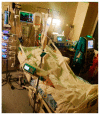Burns: Classification, Pathophysiology, and Treatment: A Review
- PMID: 36835171
- PMCID: PMC9959609
- DOI: 10.3390/ijms24043749
Burns: Classification, Pathophysiology, and Treatment: A Review
Abstract
Burns and their treatment are a significant medical problem. The loss of the physical barrier function of the skin opens the door to microbial invasion and can lead to infection. The repair process of the damage caused by the burn is impaired due to the enhanced loss of fluids and minerals through the burn wound, the onset of hypermetabolism with the concomitant disruption of nutrient supply, and derangements in the endocrine system. In addition, the initiated inflammatory and free radical processes drive the progression of oxidative stress, the inhibition of which largely depends on an adequate supply of antioxidants and minerals. Clinical experience and research provide more and more data to make the treatment of patients with thermal injury increasingly effective. The publication discusses disorders occurring in patients after thermal injury and the methods used at various stages of treatment.
Keywords: burns; pathophysiology; treatment.
Conflict of interest statement
The authors declare they have no actual or potential competing financial interests.
Figures
References
-
- Branski L.K., Herndon D.N., Barrow R.E. 1-A Brief History of Acute Burn Care Management. In: Herndon D.N., editor. Total Burn Care. 4th ed. Elsevier; Amsterdam, The Netherlands: 2018. pp. 1–7.e2.
-
- Tolles J. Emergency Department Management of Patients with Thermal Burns. Emerg. Med. Pract. 2018;20:1–24. - PubMed
-
- Ja G.-E., Vb A.-A., Eh O.-V., García-Manzano R., Barker Antonio A., Aron J., García-Espinoza J. Burns: Definition, Classification, Pathophysiology and Initial Approach. Int. J. Gen. Med. 2020;5:2327–5146. doi: 10.4172/2327-5146.1000298. - DOI
Publication types
MeSH terms
Substances
LinkOut - more resources
Full Text Sources
Other Literature Sources
Medical




